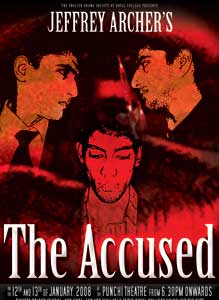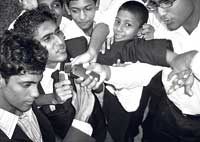
You decideOn January 12 and 13, the thespians of Royal College, Colombo will present an edgy courtroom drama – The Accused at the Punchi Theatre from 6.30pm onwards. The curtain’s of the Punchi Theatre will rise to reveal mild mannered Dr Patrick Sherwood, whose fate will depend on the hands of the audience…
Faithful husband? Or ruthless killer? You decide! In this clear example of "art imitating life," a prominent surgeon is on trial. Five supplementary witnesses are rapidly dispatched, preceding the appearance of the most important witness, Jennifer Mitchell, the woman for whom Dr Sherwood may just have committed murder. The witnesses detail evidence that strangely support both the prosecution and the defense. After 25 years of hypnotizing his readers with intriguing characters, nifty plots and signature shocker endings, political survivor Jeffery Archer came to London stage as an accused of murder in one of his own plays. In the scenario that Archer had devised, Dr. Patrick Sherwood is accused of the murder of his wife by injecting her with prescription medicine, which was purchased by Sherwood's colleague nurse Jennifer Mitchell. Evidence is presented by a porter, a pharmacist, a professor of pharmacy, a police inspector and finally, Jennifer Mitchell herself. The prosecution is defended by a left wing barrister, while Sherwood is defended by an establishment figure, Sir James Barrington. In the final scene of the trial Sherwood takes the witness stand himself. Doctor Sherwood has a strong alibi, but nurse Mitchell, who testifies to be his former mistress, offers evidence that no one, other than the doctor himself could have murdered the victim. Her testimony is convincing in one part and filled with loopholes in another. The dialogues are crisp and humorous, especially enjoyable are the occasional put-downs, interventions and asides the opposing lawyers present against each other, which from the barristers would never be seen, let alone tolerated in a real courtroom. "It is easy to fall under the spell of the play, because it eludes reality, and yet explores a real life situation through witty and sometimes absurd dialogue. For example, real lawyers would not be allowed to behave as informally as they are allowed to in the play," Yasas said. As the risk factor rises, the two principal characters will sketch out their account of the incident. One of the two has to be lying; and as the mystery gets thicker, with both parties defending their case with an equal amount of seemingly credible evidence, the audience will have to distinguish the red herrings from the truth.
As quirky as it is, the piece justifies its strange existence, moving in clever lateral thrusts as it ponders on the paradox of the law and the theatre, both of which the mission is to seek out truth, all the same prone to wane into a game played by hirelings. The decision will give rise to an anticipated "twist in the tale" finish." Since both the defense and the prosecution have strong evidence supporting their case, the audience will be thoroughly confused by the end of the play," Feroz says."Did Dr. Patrick Sherwood murder his wife?" "Was Jennifer Mitchell his mistress?" "Which of his alibis should you believe?" The decision should keep the audience at the edge of their seats... At the end of the trial, you will be responsible for Dr. Sherwood's fate. Two different endings await the decision of the audience– only then, will you discover the truth. |
|| Front
Page | News | Editorial | Columns | Sports | Plus | Financial
Times | International | Mirror | TV
Times | Funday
Times || |
| |
Reproduction of articles permitted when used without any alterations to contents and the source. |
© Copyright
2008 | Wijeya
Newspapers Ltd.Colombo. Sri Lanka. All Rights Reserved. |

